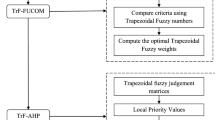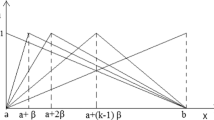Abstract
The primary goal of this research paper is to develop a tool for screening for Asperger Syndrome (AS). The “multi-criteria decision-making (MCDM)” method, an extensively used approach for making decisions involving several criteria, has been used to create this screening tool. The amount of knowledge available to a person is vast, ambiguous, and uncertain; fuzzy logic has been used to deal with ambiguity and confusion. Due to the opulence of symptoms that may cause AS, to know which symptoms affect more and which affect less, a “fuzzy analytic hierarchy process (FAHP)” algorithm has been used with the “If-Then” rule-based approach for determining whether or not an individual has an AS. The developed tool uses a hierarchy approach called “Fuzzy Tree” to reduce the huge number of rules. Efforts are being made to develop a less complex tool that can assess a person in a short period and provide accurate results. The validity of the design was verified by the two groups of individuals consisting of the AS group (N = 25) and the Typically Developed (TD) group (N = 25). It was confirmed that the method created efficiently differentiated AS participants from TD and has a precision of 99%.







Similar content being viewed by others
Data availability
Data sharing is not applicable to this article as no datasets were generated or zanalyzed during the current study.
References
Abbas H, Garberson F, Liu-Mayo S, Glover E, Wall DP (2020) Multi-modular AI approach to streamline Asperger diagnosis in young children. Sci Rep 10(1):5014. https://doi.org/10.1038/s41598-020-61213-w
Ahmadi H, Gholamzadeh M, Shahmoradi L, Nilashi M, Rashvand P (2018) Diseases diagnosis using fuzzy logic methods: A systematic and meta-analysis review. Comput Methods Prog Biomed 161:145–172. https://doi.org/10.1016/j.cmpb.2018.04.013
Ahmadi Yazdi A, Hamadani AZ, Amiri A (2019) Phase II monitoring of multivariate simple linear profiles with estimated parameters. J IndEng Int 15:557–570
Ayhan MB (2013) A fuzzy Ahp approach for supplier Selection problem: A case study in A Gearmotor company. Int J Manag Value Supply Chains 4(3):11–23. https://doi.org/10.5121/ijmvsc.2013.4302
Baio J, Wiggins L, Christensen DL, Maenner MJ, Daniels J, Warren Z, Kurzius-Spencer M, Zahorodny W, Robinson Rosenberg C, White T, Durkin MS, Imm P, Nikolaou L, Yeargin-Allsopp M, Lee LC, Harrington R, Lopez M, Fitzgerald RT, Hewitt A, Pettygrove S, …, Dowling NF (2018) Prevalence of Autism Spectrum Disorder Among Children Aged 8 Years - Autism and Developmental Disabilities Monitoring Network, 11 Sites, United States, 2014. Morbidity and mortality weekly report. Surveillance summaries (Washington, D.C.: 2002), 67(6), 1–23. https://doi.org/10.15585/mmwr.ss6706a1
Brown M, Bossley KM, Mills DJ, Harris CJ (1995) High dimensional neuro-fuzzy systems overcoming the curse of dimensionality. Proc IEEE Int Conf 4:2139–2146
Chana K, Sun X, Chung S-H (2019) When should the fuzzy analytic hierarchy process be used instead of the analytic hierarchy process? Decis Support Syst 125:113114. https://doi.org/10.1016/j.dss.2019.113114
Chang D-Y (1996) Applications of the extent analysis method on fuzzy AHP. Eur J Oper Res 95:649–655
Chatterjee D, Mukherjee B (2013) Potential Hospital Location Selection Using Fuzzy-AHP: An empirical study in rural India. IJITR 1(4):304–314
Chen GW (2018) A pilot study on evaluating children with Asperger syndrome using computer games. Comput Hum Behav 90:204–214. https://doi.org/10.1016/j.chb.2018.08.057
Dwi Putra MS, Andryana S, Fauziah, Gunaryati A (2018) Fuzzy analytical hierarchy process method to determine the quality of gemstones. Adv Fuzzy Syst 2018:1–6. https://doi.org/10.1155/2018/9094380
El-Sappagh SA (2018) Clinical decision support system for liver fibrosis prediction in hepatitis patients: A case comparison of two soft computing techniques. IEEE Access 6:52911–52929. https://doi.org/10.1109/access
Georgescu L, Koehler JC, Weiske JC, Vogeley K, Koutsouleris N, Falter-wagner CM (2019) Machine learning approaches to study social interaction difficulties in AS. Front Robot AI 6:132. https://doi.org/10.3389/frobt.2019.00132
Ghunaim H, Dichter J (2019) Applying the FAHP to improve the performance evaluation reliability of software defect classifiers. IEEE Access 7:62794–62804. https://doi.org/10.1109/ACCESS.2019.2915964
Grossi E, Olivieri C, Buscema M (2017) Diagnosis of autism through EEG processed by advanced computational algorithms: a pilot study. Comput Methods Prog Biomed 142:73–79
Guillaume S, Charnomordic B (2012) Fuzzy inference systems: an integrated modeling environment for collaboration between expert knowledge and data using FisPro. Expert Syst Appl 39(10):8744–8755. https://doi.org/10.1016/j.eswa.2012.01.206
Huang Y-P, Basanta H, Kuo H-C, Huang A (2018) Health symptom checking system for elderly people Using fuzzy analytic hierarchy process. Appl Syst Innov 1(2):10. https://doi.org/10.3390/asi1020010
Klar R, Zaiss A (1990) Medical expert systems: design and applications in pulmonary medicine. Suppl 168:1201–1209. https://doi.org/10.1007/BF02718262
Kosko B (2002) Global Stability of Generalized. IEEE Trans Syst Man Cybern C Appl Rev 28(3) August 1998:441
Li A (2014) Analytical hierarchy process Using fuzzy inference technique for real-time route guidance system. IEEE Trans Intell Transp Syst 15(1):84–93. https://doi.org/10.1109/tits.2013.2272579
Lim K (2002) A proposed hierarchical fuzzy inference system for the diagnosis of arthritic diseases. Australasian Phys Eng Sci Med 25(3):144–150. https://doi.org/10.1007/bf03178776
Mahmoudi M, Akbari-Zardkhaneh S, Bagher Zadeh AA, Ghobari-Bonab B, Shokoohi-Yekta M, Moradi H, Pouretemad HR (2018) An Asperger screening expert system: reliability, validity and factorial structure. Asperger-Open Access 08(03). https://doi.org/10.4172/2165-7890.1000230
Malik ZA (2017) Early detection of autism for children using ruled based system. Terengganu, Malaysia
Mutlu S (2018) End-to-end hierarchical fuzzy inference solution. IEEE Int Conf Fuzzy Syst (FUZZ-IEEE). https://doi.org/10.1109/fuzz-IEEE.2018.8491481
Mythili MS, Mohamed AR (2016) An improved autism predictive mechanism among children using a fuzzy cognitive map and feature extraction methods (FEAST). ARPN J Eng Appl Sci 11:1819–1828
Najafi ML, Nasiri M (2013) Identification and prioritizing the effective factors on addiction by use of Fuzzy analytical hierarchy process (F-AHP). Life Sci J 10(9s)
Nazari S, Fallah M, Kazemipoor H, Salehipour A (2018) A fuzzy inference- fuzzy analytic hierarchy process-based clinical decision support system for diagnosis of heart diseases. Expert Syst Appl 95:261–271. https://doi.org/10.1016/j.eswa
NINDS. (2015, September) Retrieved February 1, 2020, from https://www.ninds.nih.gov/Disorders/Patient-Caregiver-Education/Fact-Sheets/Asperger-Spectrum-Disorder-Fact-Sheet#3082_1
Nouei MT, Kamyad AV, Ghazalbash S, Sarzaeem MR (2013) Application of fuzzy-AHP extent analysis to determine the relative importance of risk factors in operative mortality after coronary artery bypass surgery. Int J Comput Sci Eng 5(5)
Oguztimur S (2011) Why fuzzy analytic hierarchy process approach for transport problems
Pratap A, Kanimozhiselvi CS, Pramod KV, Vijayakumar R (2014) Functional fuzzy-based autism assessment support system. Int J Eng Technol 6:2105–2114
Pratap A, Kanimozhiselvi CS, Vijayakumar R, Pramod KV (2016) Parallel neural fuzzy-based joint classifier model for grading autistic disorder soft computing applications. Adv Intell Syst Comput 356:13–26. https://doi.org/10.1007/978-3-319-18296-4_2
Psychological Assessment of Asperger Syndrome (2002) Understanding Asperger syndrome and high functioning autism. The autism Spectrum disorders library, vol 1. Springer, Boston. https://doi.org/10.1007/0-306-47679-7_3
Rdionovs A, Užga-Rebrovs O (2017) Software tool implementing the fuzzy AHP method in ecological risk assessment. Inf Technol Manag Sci 20. https://doi.org/10.1515/items-2017-0006
Russo R d FM, Camanho R (2015) Criteria in AHP: A systematic review of literature. Procedia Comput Sci 55:1123–1132. https://doi.org/10.1016/j.procs.2015.07.081
Saaty TL (1990) Decision making for leaders: the analytic hierarchy process for decisions in a complex world. RWS publications
Savić S, Stanković M, Janaćković G(2013) Fuzzy AHP ranking of occupational safety system quality indicators. Information Theory and Complex Systems. 29
Sharma A, Sharma A, Malhotra R, Singh P, Chakrabortty RK, Mahajan S, Pandit AK (2021) An accurate artificial intelligence system for the detection of pulmonary and extra pulmonary Tuberculosis. Tuberculosis (Edinb) 131:102143. https://doi.org/10.1016/j.tube.2021.102143
Sharma, Khosla A, Khosla M, Rao Y (2018) Fast and accurate diagnosis of Asperger (FADA): a novel hierarchical fuzzy system-based Asperger detection tool. Australas Phys Eng Sci Med 41:757–772. https://doi.org/10.1007/s13246-018-0666-3
Spoorthy MS, Pratapa SK, Mahant S (2020) Mental health problems faced by healthcare workers due to the COVID-19 pandemic-A review. Asian J Psychiatr 51:102119. https://doi.org/10.1016/j.ajp.2020.102119
Uzoka M (2010) Expert systems and uncertainty in medical diagnosis: a proposal for fuzzy-ANP hybridization. Int J Med Eng Inform 2(4):329. https://doi.org/10.1504/ijmei.2010.036305
Van de Kaa G, de Vries HJ, van den Ende J, Rezaei J (2014) Supporting decision making in technology standards battles based on a fuzzy analytic hierarchy process. IEEE Trans Eng Manag 61(2):336–348. https://doi.org/10.1109/TEM.2013.229257
WHO. (2022, October 1) Retrieved 2022, from World Health Organisation: https://www.who.int/news-room/fact-sheets/detail/Asperger-spectrum-disorders
Acknowledgements
All the authors have contributed equally to the manuscript. I, the first author of the manuscript, would like to thank all the authors for their expertise and assistance throughout all aspects of our study and for their help in writing the manuscript.
Author information
Authors and Affiliations
Corresponding author
Ethics declarations
Conflict of interest
The authors confirm that there are no known conflicts of interest associated with this publication, and there has been no significant financial support for this work that could have influenced its outcome.
Additional information
Publisher’s note
Springer Nature remains neutral with regard to jurisdictional claims in published maps and institutional affiliations.
Rights and permissions
Springer Nature or its licensor (e.g. a society or other partner) holds exclusive rights to this article under a publishing agreement with the author(s) or other rightsholder(s); author self-archiving of the accepted manuscript version of this article is solely governed by the terms of such publishing agreement and applicable law.
About this article
Cite this article
Sharma, A., Chakrabortty, R.K., Sharma, V. et al. A multi-criteria decision-making tool for the screening of Asperger syndrome. Multimed Tools Appl 82, 34095–34111 (2023). https://doi.org/10.1007/s11042-023-14996-9
Received:
Revised:
Accepted:
Published:
Issue Date:
DOI: https://doi.org/10.1007/s11042-023-14996-9




